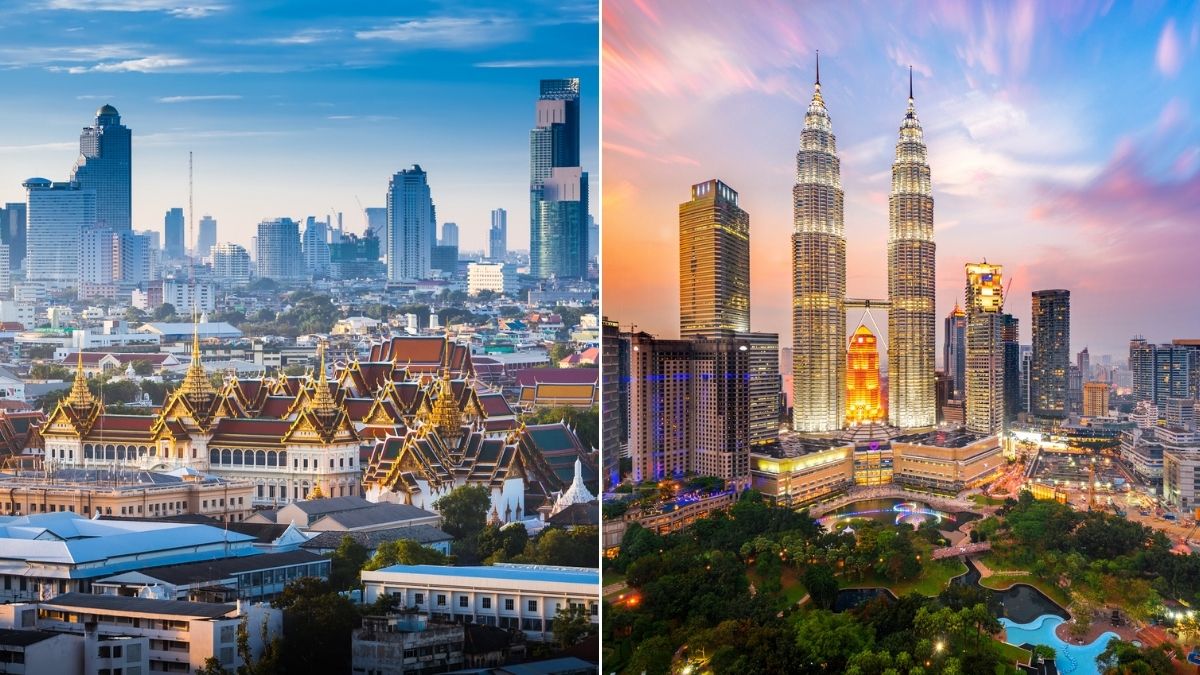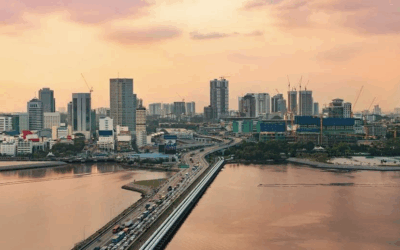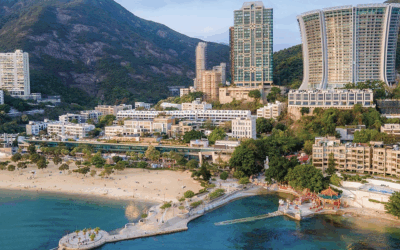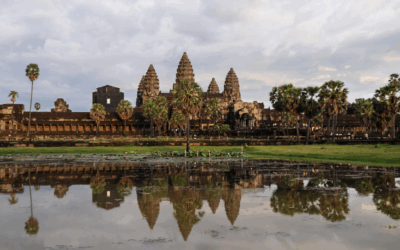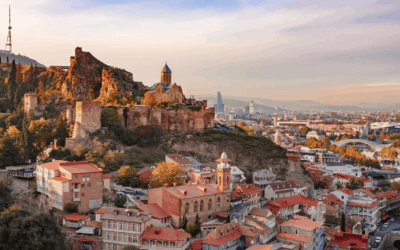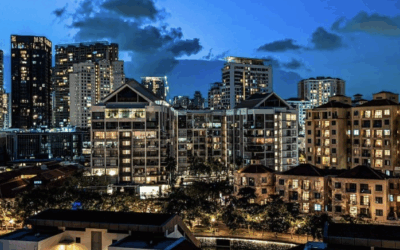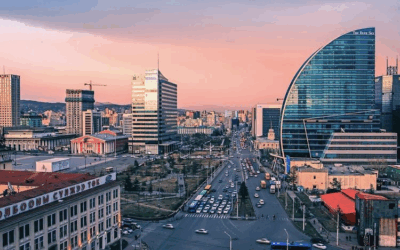Last updated March 28th, 2025.
Among Southeast Asia’s vibrant cities, Bangkok and Kuala Lumpur are hard to resist for many foreign expats.
Looking at Southeast Asia as a whole, these two cities stand out for their cultural richness and cost-to-quality ratio.
Kuala Lumpur and Bangkok appear similar on the surface. But dive deeper and you’ll uncover many differences, some of which might even become dealbreakers that would make you reconsider moving to one of them.
Bangkok is a vibrant city that is adorned with golden temples and bustling markets. The aroma of sizzling street food fills the air.
Meanwhile, Kuala Lumpur’s metro area is only half the size of Bangkok. Yet the Malaysian capital is a melting pot of culture and flavors. The city has a unique type of elegance with skyscrapers towering over lush green parks.
Let’s delve deep into both Bangkok and Kuala Lumpur to get a good look at both of these remarkable cities. We’ll compare pros and cons, and what they offer to expats, tourists, and investors alike.
Hopefully, by the end of this article, you’ll have a clearer idea whether Bangkok or KL fits your lifestyle better.
The decision to choose one over the other isn’t merely practical; it’s a personal one – a choice that speaks to who you are and what you seek.
Housing in Bangkok vs. Kuala Lumpur
If you’re looking to buy property, both Bangkok and Kuala Lumpur have plenty of options when it comes to their real estate markets.
Generally, housing in Kuala Lumpur offers more value for money. Bangkok has greater variety though.
Bangkok
Bangkok’s real estate market has attracted significant foreign investment in recent years. The city’s strategic location, growing economy, and tourism appeal make it a promising destination for property investors.
Rental yields in Bangkok are highest for condos in central locations, especially those near BTS Skytrain and MRT stations. You can expect about 5% yields on one-bedrooms and 3% for two-bedrooms.
Bangkok’s rental yields are thus considered low-to-moderate compared to Southeast Asia as a whole. Generally, smaller units yield higher. They’re also harder to rent because of an oversupply of one-bedroom condos though.
You can own freehold condos in your own name as a foreigner. That said, there are a few restrictions and regulations. Foreign citizens can own up to 49% of the total floor area of any given condo building, and can’t directly own land.
When it comes to finding a place to rent or buy, both Bangkok and Kuala Lumpur offer a range of options. It all depends on your preferences and budget.
Bangkok has everything from the traditional Thai-style houses to modern condominiums and apartments, where luxurious high-rises stand alongside quaint townhouses.
- Condominiums are popular among expatriates and young professionals, offering amenities such as swimming pools, gyms, and an added layer of security. While prices will differ based on the location and the size, a two-bedroom unit in a central location (e.g. Sukhumvit or Silom) will set you back $1,000-$3,000 a month.
- Townhouses and detached homes are, perhaps, a better option if you’re seeking more space and privacy. Many of the homes feature traditional Thai architectural elements, which is a nice touch. Monthly rent ranges from $800-$2,500—so a little cheaper than a condo.
In no particular order, here are Bangkok’s top 3 neighborhoods. Each of them caters to a different lifestyle:
- Sukhumvit. Known for its vibrant nightlife, shopping, and dining options, Sukhumvit is popular among expatriates and young professionals.
- Sathorn. A prime business district, Sathorn offers upscale condominiums and proximity to international schools.
- Ratchathewi. For those seeking a more authentic Thai experience while still being in the city center, Ratchathewi, home to Victory Monument and Soi Rangnam, offers great food and a wide range of housing options.
Kuala Lumpur
Kuala Lumpur’s price per square meter currently stands at about half of Bangkok. There’s still a lot of growth potential left.
Plus, Malaysia’s quality infrastructure and business-friendly policies make it an attractive option for investors.
Real estate in prime locations such as Kuala Lumpur City Center (KLCC) have shown steady capital appreciation, reflecting the city’s economic growth. Meanwhile, areas popular with expats, e.g. Mont Kiara, show strong rental demand, especially for families.
They’ve also made it easy live in the country as a long-term resident via the Malaysia My Second Home (MM2H) program, which provides residency options to qualifying investors.
Keep in mind that foreigners must meet a minimum purchase price when buying property in Malaysia, and this price varies by state and property type.
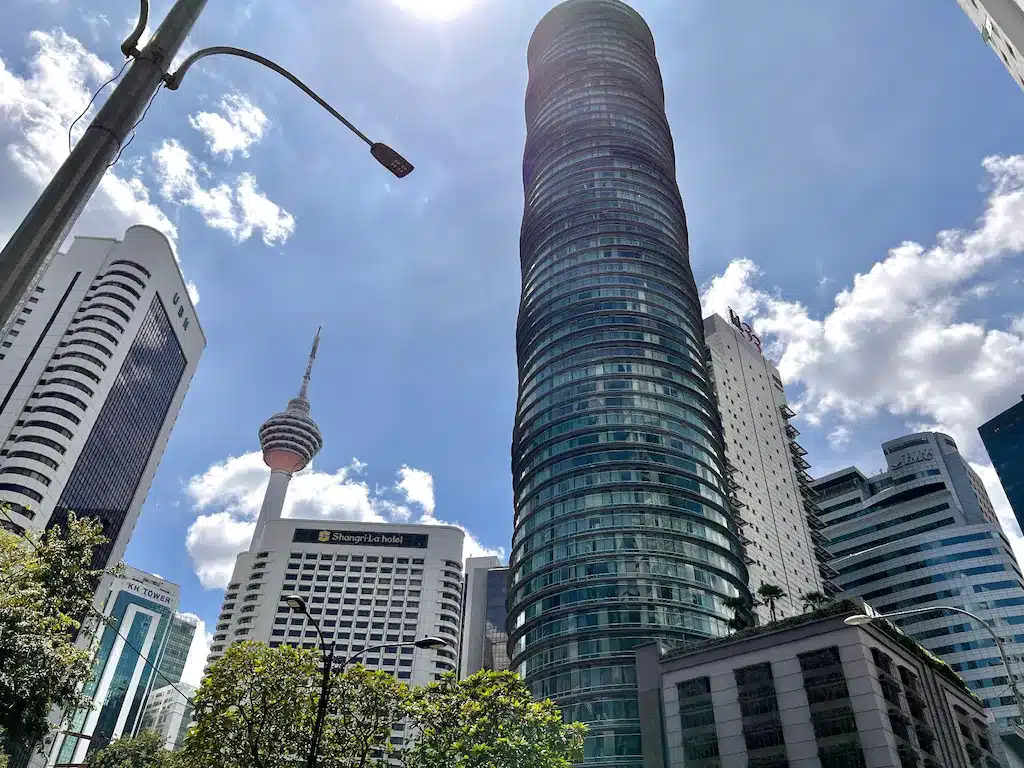
You can buy a condo in Kuala Lumpur’s city center for about $4,000 per square meter. That’s similar to prices in nearby Manila, Jakarta, and Hanoi, all of which are less developed than KL.
Overall, Kuala Lumpur’s housing market is known for modernity and cosmopolitan appeal. That said, the city offers a range of housing options to suit different tastes and budgets.
- Condominiums and apartments in Kuala Lumpur are known for their over-the-top amenities. But, more importantly, they’re usually placed in highly strategic locations near business districts. A two-bedroom unit may cost anywhere between $800 and $2,500 per month.
- Bungalows and semi-detached homes offer more space and usually include an outdoor area, too. These are popular among families, with rents ranging from $1,500 to $4,000.
Here are three of Kuala Lumpur’s neighborhoods where you can start your accommodation search:
- KLCC. The heart of Kuala Lumpur, Kuala Lumpur City Center is home to iconic landmarks and luxurious properties.
- Mont Kiara. Popular with expatriate families, Mont Kiara offers international schools, family-friendly amenities, and spacious homes.
- Bangsar. Known for trendy cafes and boutiques, Bangsar attracts young professionals and creative types.
Business Opportunities Compared
Bangkok and Kuala Lumpur, as two of Southeast Asia’s largest cities, are also some of its main economic powerhouses.
Demand for both cities is rising among global investors and businesses, yet there are also crucial differences between the two. Let’s dive in!
Bangkok
As the nation’s capital, businesses in Bangkok contributes heavily to the economy. In fact, more than half of Thailand’s entire GDP is from Bangkok.
The city’s main industries are tourism, manufacturing, and services.
- Tourism comes as no surprise, as Bangkok is one of the world’s top tourist destinations, attracting millions of visitors annually. The city’s rich cultural heritage, the bustling street markets, and top-shelf nightlife options contribute to its tourism appeal.
- Services are another important part of the economy of the city. Finance, healthcare, and education have all experienced significant growth as the city grows, the middle class expands, and the number of expats increases.
- There’s also manufacturing in Bangkok, particularly the auto, electronics, and food processing sectors. That’s because the city’s port easily facilitates the export of goods to international markets.
Bangkok is also popular with investors. The main opportunities lie in real estate, startups, and hospitality
- Residential property is a no-brainer, as the city continues to grow. It’s not just the urbanization of Bangkok either. Many thousands of foreigners call Bangkok home, often bringing their families, too, thanks to high-quality education and healthcare.
- Startups are flourishing in Bangkok, as the city has seen a huge surge in the arrival of entrepreneurs. The government has launched initiatives to support the digital economy.
- Hospitality is another sector to invest in, as Thailand is a huge tourist destination. Cafes, restaurants, hotels, and entertainment venues in Bangkok are all in high demand as tourist numbers continue to grow.
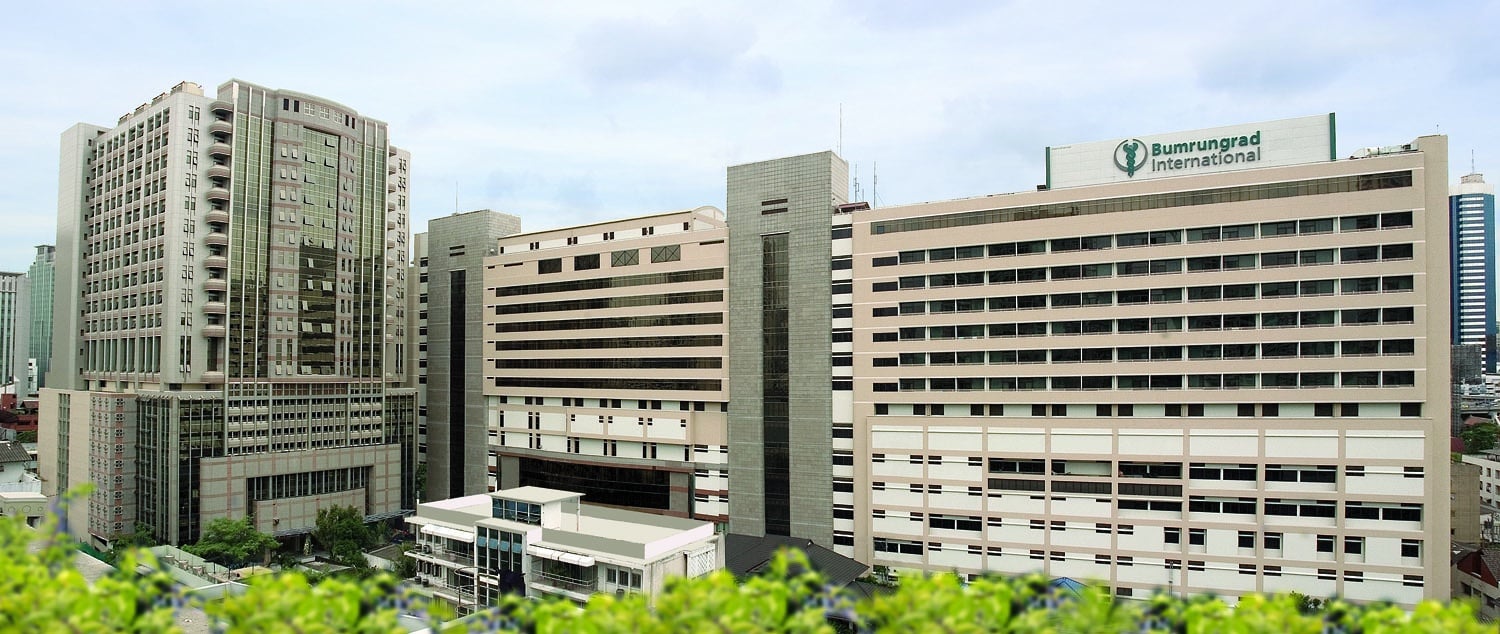
Thai hospitals are ranked among the world’s best. Getting treatment at one of the nation’s top private hospitals generally costs between 25%-50% compared to prices in the US or Europe.
Kuala Lumpur
We’ll cut to the chase—Kuala Lumpur’s economic strength lies in finance, IT, and services.
The city’s modern infrastructure and business-friendly policies make it a top-choice destination for multinational corporations and startups looking to operate in or out of Asia.
Here are the top three economic sectors in Kuala Lumpur:
- Finance is a sector that underpins Kuala Lumpur’s economy. After all, the city is home to the Kuala Lumpur Stock Exchange (Bursa Malaysia) and serves as a financial and investment hub for the region.
- Manufacturing is huge in Kuala Lumpur, focusing predominantly on the automotive and biotech industries. There is also the presence of electronics manufacturing.
- Services is a sector that Kuala Lumpur is strong in. It encompasses education, healthcare, and tourism, reflecting its cosmopolitan appeal and strategic positioning.
When it comes to large investment projects, infrastructure, Islamic finance, and services are Malaysia’s three main economic drivers.
- Infrastructure projects, such as the Mass Rapid Transit (MRT) system, offer foreign investors plenty of opportunities to make money. Since the city is growing rapidly, new opportunities arise regularly.
- Islamic finance. Now, this might be unfamiliar terrain to some, but banking that is Shariah law-compliant is in huge demand in the Islamic world. Kuala Lumpur is one of the world’s largest centers of Islamic finance.
- The need for high-quality services is ever-increasing as the city continues to expand. For example, high quality education, healthcare services, and even hospitality are all in high demand. If that’s your kind of investment style, you’re in luck.
Education and Healthcare
Education and healthcare are important factors when considering a move to a different country and city. That’s especially true if you have children or are retired.
Thankfully, Bangkok and Kuala Lumpur offer quality and quantity on both fronts. We’ll compare the two cities
For the most part, Kuala Lumpur and Malaysia as a whole has a better educational system than Thailand. Hospitals are of a similarly high quality in both places though.
Bangkok
Education in Thailand is free and mandated up to the age of 16. Government-run schools provide education in Thai, with English taught as a second language.
However, only about a third of the Thai population speaks some level of English, which goes to show that the public schooling system isn’t great.
If you’re considering moving to Bangkok with your family, private schools or international schools will appeal more.
Bangkok is home to numerous schools offering international curricula, such as the International Baccalaureate (IB), British, and American educational systems. Obviously, these pricey schools cater primarily to expats and rich locals.
And when it comes to college education, there are several top universities in Bangkok, namely Chulalongkorn University and Thammasat University, which both turn out skilled graduates for Bangkok’s workforce.
On a similar note, there are a handful of world-class medical facilities in Bangkok. In fact, Bangkok is renowned for its medical tourism, attracting patients not just from Asia, but from around the world.
Hospitals such as Bumrungrad International Hospital are known for their high standards, state-of-the-art facilities, English-speaking staff, and relative affordability.
We’d go as far as to say you could possible pay for most medical expenses out of pocket and never even require expensive health insurance.
If that’s not for you, however, there are private insurance options that cater to both locals and expats.
Kuala Lumpur
The educational system in Malaysia is very similar to that in Thailand. Education is free and compulsory up to high school. It’s conducted mostly in Malay, but English, Tamil, and Mandarin also feature as languages of instruction.
If you have children, you’d most likely enroll them in private schools, as there are many international schools that follow curricula of Britain, America, Australia, or even Germany.
Higher education is heavily subsidized by the government, which means that a lot of the population study at university.
A handful of universities in Malaysia have made it to the Top 200 Universities in the World list and are known for their research and academic excellence.
Generally speaking, Malaysian colleges are better than their Thai counterparts. QS World University Rankings puts Universiti Malaya at 65th place, which is notably higher than any school in Thailand.
The thread of excellence continues when talking about healthcare standards. Although it might not be the healthcare hub that Bangkok is, Kuala Lumpur’s healthcare system is accessible, well-equipped, and more than enough if you’re living there.
There are public and private hospitals offering advanced medical services and accredited by international organizations.
Malaysia’s government also heavily subsidizes healthcare, which makes essential services accessible to all – no expensive premiums here.
Culture and Entertainment
You could theoretically drive from Bangkok to Kuala Lumpur in a few very long days; it’d take you 20 hours.
As such, you might assume the cultural and the entertainment scenes in Bangkok vs. Kuala Lumpur would be similar.
In a sense they are. Both offer rich and diverse cultural and entertainment landscapes. But whereas Bangkok is known for its top-class nightlife and street food, Kuala Lumpur is more about shopping and lounges.
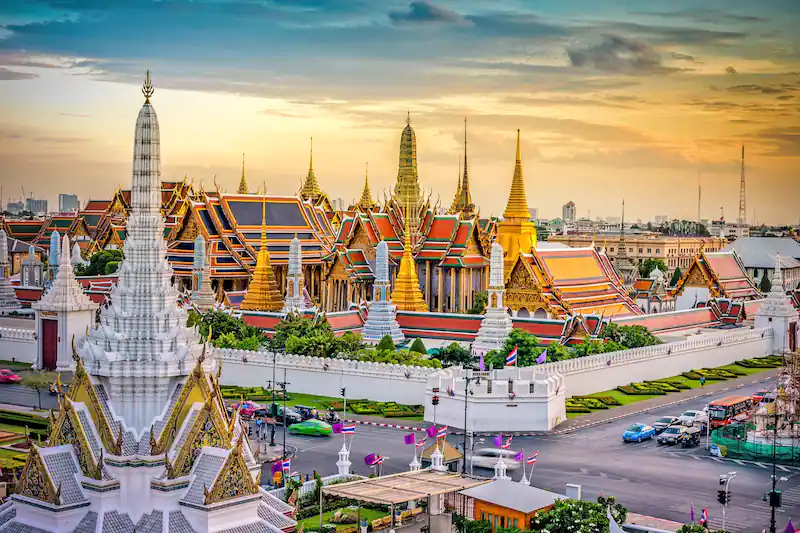
Malaysian culture is characterized by its range of Indian, Chinese, and Malay influences. By comparison, Thailand’s national culture is more unique and pronounced.
Bangkok
Dozens of Asian cities are renowned for rich culture and a dynamic entertainment scene, but Bangkok truly stands out. The influences of Buddhism and Thai customs and traditions are visible everywhere you go, in fact.
Bangkok’s cultural heat beats in its stunning temples such as Wat Phra Kaew and Wat Arun. These architectural marvels are not just tourist attractions either. They’re active centers of Buddhist practice.
Traditional arts, Thai classic dance, puppetry, and music can be enjoyed in many venues across the city. And that’s not to mention the many festivals that Bangkok residents and visitors get to enjoy throughout the year.
Songkran (Thai New Year) and Loy Krathong (Festival of Lights) both offer immersive and traditional Thai experiences.
The food experience in Thailand is second to none. Its many streets are lined with street food vendors offering authentic Thai fare, and then there are the floating markets that one simply has to experience.
Finally, as far as entertainment goes, Bangkok comes alive at night. There are almost too many places to choose from, from upscale rooftop clubs to budget-friendly street-level pubs.
Overall, Bangkok has a rowdy reputation when it comes to nightlife, so if you tend to go ‘all out’ when you go out, you’ll feel right at home in Thailand’s capital.
Kuala Lumpur
Whereas Bangkok is deeply rooted in Thai traditions and Buddhism, Kuala Lumpur is more of a cultural melting pot. Malaysia doesn’t consist of one distinct culture.
With its shopping streets and high-end malls where you can find all of the world’s fanciest brands, Kuala Lumpur is great for shopaholics. Malls like Suria and Pavilion are unlike anything you’ve probably seen elsewhere.
Similarly, Malaysian dining is top-notch, with plenty of fine restaurants and interesting fusion establishments, thanks to the multicultural facet of the city. And if it’s traditional fare you want, you can eat at the hawker centers for a moderate price.
Malaysia’s food scene is versatile. The local Peranakan cuisine – a unique blend of Indian and Chinese flavors – is delicious and hard to find outside the country.
However, Bangkok offers a wider range of food options by comparison. The city’s size means you’ll have access to obscure eats, like Georgian food and Chicago-style pizza.
When it comes to culture, Kuala Lumpur celebrates its many influences, from Malay, Chinese, and Indian to Western. That’s why the culture and arts scene features a mix of both traditional and contemporary styles.
Malaysia as a whole also celebrates many diverse festivals, such as Hari Raya Aidilfitri (Eid), Chinese New Year, Deepavali, and others, reflecting its multicultural make-up.
Cost and Quality of Life
Two huge factors of choosing a place to live are the cost and the quality of life. Afterall, a place might be cheap to rent, but if you’re not comfortable there, you won’t thrive.
Simply put, the cost of living in Bangkok is 32% higher than in Kuala Lumpur, as estimated by numbeo.com
And if you’re specifically looking at real estate values, the differences are even more stark. Renting or buying a condo in central Bangkok will generally cost double compared to one of a similar size and location in KL.
Granted, your exact costs will depend on lifestyle, number of family members, and dozens of other factors. There isn’t any “one size fits all” number, and the price of real estate will vary based on your living and spending habits.
Comparing these numbers is a good start though – you can expect to pay about 30% more for housing in Bangkok verses Kuala Lumpur.
Weather
Both cities have a tropical climate. That means heat and humidity, so you need to be comfortable with those conditions to have a good time in either city.
That said, Bangkok’s weather tends to be hotter and more humid. Kuala Lumpur has plenty of city parks and a greener environment overall, which absorbs some of the heat, or, at the very least, allows you to escape to a cooler place during the midday temps.
Another thing you should consider is air pollution. Both cities suffer from significantly polluted atmospheres, some of it coming from the transport, and some of it from the manufacturing plants near the cities.
There’s no way to escape heat or pollution in Bangkok, Kuala Lumpur, or even Singapore – it’s a regional problem. Still, you can take action to mitigate some of these risks to health, e.g. going on a holiday when the air gets too bad.
Transportation
Both cities have decent transportation systems that are simple to understand and affordable. Ride sharing apps are plentiful, and taxi fares are generally cheap.
Bangkok’s narrow streets can get congested. In fact, the traffic is ‘legendary’ and can quickly overwhelm newcomers – it’s a chaotic urban environment that’s not suitable to all.
As a city, Kuala Lumpur feels a bit more organized. However, Bangkok’s public transport network is more comprehensive. You’re able to get around without a car much easier in Bangkok between its skytrain, subway system, network of canals, and trains.
By comparison, Kuala Lumpur is a city where people use their private cars much more often, similar to America. Consider it more like Dallas, and less like Manhattan, as far as city planning goes.
If getting around by public transport or on foot appeals to you, that might be harder to pull off in Kuala Lumpur verses Bangkok.
Safety
The main safety concern in both these cities is petty crime, such as bag snatching and pickpocketing. Just use common sense, don’t walk around in dark unfamiliar areas of the city on your own, and don’t leave your drink unattended.
Both cities are generally safe, and likely moreso than a major city in your home country. Yet regarding crime levels, Bangkok is safer than Kuala Lumpur.
A general consensus among locals is that bag-snatching, pickpocketing, and theft have become a greater concern in KL in the past several years. Especially in the KLCC and KL Sentral areas.
On an international level, Malaysia ranks much higher on the Global Peace Index (18) than Thailand (103) for what it’s worth.
While some of the measures that the index uses are irrelevant to everyday living and tourism, it also measures the level of societal safety and security, so it’s worth paying attention to.
Bangkok is a safer city than Kuala Lumpur in the grand scheme of things, but you’re highly unlikely to run into issues in either place.
Which City is Better?
It’s no small feat to choose which city you’ll be relocating to. Luckily, you can’t go wrong with either of these locations in the battle of Bangkok vs. Kuala Lumpur.
Both cities are Asian powerhouses in their own right, offering plenty of opportunities for both business and leisure.
Bangkok has lots of raw energy and cultural vibrancy. There’s a greater variety of dining, entertainment, and shopping options because Bangkok is a much larger city compared to KL. Despite this, crime rates are very low and it’s an overall safer city.
However, Kuala Lumpur pulls out all the stops with its modern amenities and affordable luxury. The city is well-organized and feels slightly more developed than Bangkok does. English is also spoken more widely.
Both cities stand testament to Southeast Asia’s growth, diversity, and endless investment potential – enjoy!
FAQs: Bangkok vs. Kuala Lumpur
Can Foreigners Legally Own Property in Both Bangkok and Kuala Lumpur?
Yes, foreigners can legally own property in both cities, but the rules differ. In Bangkok, foreigners can own freehold condominiums in their own name, but only up to 49% of the total floor area in any given condo building. They cannot directly own land.
In Kuala Lumpur, foreigners can also own condominiums and landed property, though there is a minimum purchase price that varies by state. Malaysia’s property laws are generally considered more flexible and foreigner-friendly, especially under the Malaysia My Second Home (MM2H) program.
Which City Offers Better Long-Term Growth Potential in Real Estate?
Kuala Lumpur is generally seen as having more room for growth. The city’s property market is still developing, and its prices are relatively low compared to other Asian capitals. KL’s infrastructure, economic development, and business-friendly policies contribute to steady capital appreciation, especially in prime areas like KLCC.
Bangkok, while more mature, faces challenges such as oversupply in suburban condo markets and slower GDP growth, which may limit future price increases.
How Do Real Estate Prices Compare Between Bangkok and Kuala Lumpur?
Real estate in Kuala Lumpur is significantly more affordable than in Bangkok. On average, the price per square meter in KL is about half that of Bangkok.
Renting or buying a condo in central Bangkok will typically cost twice as much as a similar unit in Kuala Lumpur. This makes KL a more cost-effective option for investors seeking value for money.
What Are the Rental Yields Like in Both Cities?
In Bangkok, rental yields are considered low-to-moderate by regional standards. One-bedroom condos in central areas yield around 5%, while two-bedroom units yield closer to 3%.
In Kuala Lumpur, rental yields are also modest, but areas popular with expats—such as Mont Kiara—show strong rental demand, particularly for family-sized units.
Which City is More Suitable for Lifestyle-Focused Investors?
This depends on personal preferences. Bangkok offers a vibrant cultural scene, world-famous street food, and dynamic nightlife. It’s ideal for those who enjoy an energetic, urban lifestyle.
Kuala Lumpur, on the other hand, is more relaxed, with a greener environment, modern infrastructure, and a multicultural atmosphere. It’s especially attractive for families and those seeking a balance between city life and comfort.

